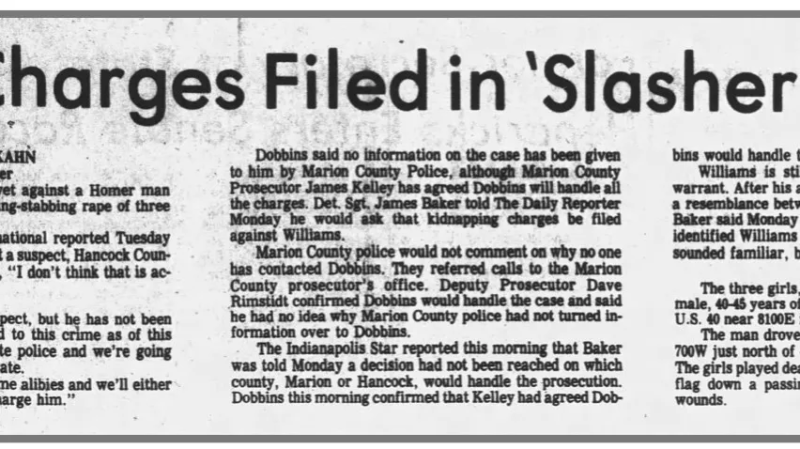Indiana police identified suspect who left girls for dead in 1975. Genealogy testing played a key role in the case.
INDIANAPOLIS — Indianapolis Metropolitan Police announced a major break in a nearly 50-year-old cold case that involved three hitchhiking girls and one man who detectives at the time said was "hunting" for victims.
The elusive suspect behind the horrific attacks on the young girls in a field was identified during a news conference Thursday, providing an answer to the investigation decades after it horrified the city. Thomas Edward Williams — dubbed the 'Slasher' by police and the victims — died at age 49 in November 1983 inside a prison in Galveston, Texas. At the time of the abduction, Williams lived near the site of the kidnapping.
"This was an act of evil that none of (the women) deserved," said Indianapolis police Sgt. David Ellison, who's now retired. "I hope today brings you some sort of closure, knowing your attacker has been identified and he's no longer in this world."
Authorities say three girls, ages 11, 13, and 14, were hitchhiking in Indianapolis in 1975 when they were picked up by a man. The man took them to a cornfield in Hancock County, where police say he raped the youngest girl and stabbed her in the throat and chest; then slashed the throats of the other two girls.
Two of the victims made their way to U.S. 40, where passersby picked them up, took them to a motel, and called authorities. Law enforcement later found the youngest survivor in the cornfield.
The three victims — Sheri Rottler Trick, Kathie Rottler, and Kandice Smith — have relentlessly pushed law enforcement to reveal the name of their assailant. At the time of the abduction, Williams lived near the site of the kidnapping.
Authorities solved the case through genealogy testing. A DNA match was confirmed with swabs from Williams' daughter and son, leading to his identification as a suspect.

Case went cold after charges were dropped
IndyStar, part of the USA TODAY Network, has completed extensive interviews with the law enforcement first on the scene in 1975, the driver of the car who picked up two girls, multiple detectives who tried to crack the case and the three survivors who have waited nearly 50 years for answers.
Steve Gibbs, at the time a detective sergeant with the Marion Co. Sheriff's, picked up the cold case and described the assailant this way in an interview with IndyStar in 2018.
"He was hunting," he said. "I would hate to use the word professional, but he was a hunter ... of victims. Once you're in his car, it's like being caught in a spiderweb, there's no getting out."
One officer, who arrived first on the motel scene, compared the cuts to the girls' necks as appearing similar to that of an accordion. Against all odds, the girls survived, and so ensued the hunt for who was behind their heinous assault.
Police and family members begged the public for any information. Newspaper clippings shared leads and provided suspect sketches from what the girls relayed to artists. Leads were followed, and after ruling out suspects, the investigation stalled.
In 2018, Kathie Rottler was connected with Ellison from the Indianapolis Police Department's cold case unit, who agreed to take on the investigation. On Jan. 9, 2019, the women got their DNA swabbed after Ellison picked the case.
'I'm at peace now in my heart'
The assault and stabbings ignited a flurry of calls for tips and leads to the identity of the suspect. As year after year passed, the women said it seemed their hope for an answer dwindled.
"It seemed every call I made as met with another dead end," Kathie Rottler, one of the survivors, said during the Thursday news conference. Rottler said at the same time, she was determined not to give up.
"I'm at peace now in my heart," Kandice Smith said.
From a podium, Rottler Trick shared her feelings toward Williams.
"I do forgive this man," she said. "I had to in order to continue my life. I hope anybody who’s in this situation can please do the same."
Genealogy testing played a key role in identifying Williams
Ellison said three separate DNA profiles recovered from evidence returned to one unknown male. Investigators partnered with a private forensic laboratory, DNA Labs International, and with the funding help from media company Audiochuck, and used their genealogy testing to identify Williams' son and daughter.
From there, they identified Williams as the suspect.
The Indianapolis case is one of many in recent years when a long-unsolved crime got a break from genealogy testing. Genetic genealogy testing "combines DNA testing with traditional genealogical methods to identify biological relationships and trace ancestral lines," wrote Marc McDermott, an investigative genetic genealogist, for the educational website GeneologyExplained.
Authorities across the nation have also used genealogy testing and surreptitious DNA collection to solve other cold cases over the last few years. Detectives used genealogy testing to identify the famously-known Golden State Killer, who committed a series of murders, rapes, and burglaries across California in the 1970s and 1980s and a Vermont case in which police charged William DeRoos with killing a second-grade teacher Rita Curran, 24, in 1971.
Contributing: Marisa Kwiatkowski, Mykal McEldowney, Kayla Jimenez; USA TODAY Network
Disclaimer: The copyright of this article belongs to the original author. Reposting this article is solely for the purpose of information dissemination and does not constitute any investment advice. If there is any infringement, please contact us immediately. We will make corrections or deletions as necessary. Thank you.







